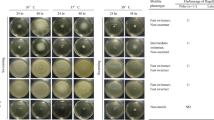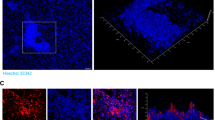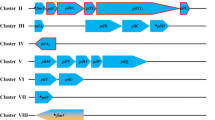Abstract
The relationships between specific type IV pili (TFP) groups and antibiotic resistance, biofilm formation, and bacterial motility were determined in 190 Pseudomonas aeruginosa clinical isolates. While motility and biofilm formation were determined by phenotypic assays, the presence of TFP was determined by PCR assay and antibiotic susceptibility by disk diffusion. The results showed a high ability to form biofilm (97.4%), multidrug resistance (44.7%), and the presence of a high number of motile isolates. We also found an association between strong biofilm production and multidrug resistance. Furthermore, TFP group III was associated with strong biofilm production. In contrast, the isolates with TFP group II and those without any TFP were associated with non-strong biofilm production. Regarding motility, TFP group II was associated with higher percentages of swarming, swimming, and twitching, while TFP group I showed lower percentages of swarming and twitching, and TFP group III showed lower levels of swarming and swimming. In conclusion, these findings highlight the differences in P. aeruginosa phenotypes related to the presence of specific TFP groups and their potential implications in clinical settings.




Similar content being viewed by others
References
Ahmed MN, Porse A, Sommer MOA, Høiby N, Ciofu O (2018) Evolution of antibiotic resistance in biofilm and planktonic Pseudomonas aeruginosa populations exposed to subinhibitory levels of ciprofloxacin. Antimicrob Agents Chemother 62:e00320–e00318
Anyan ME, Amiri A, Harvey CW, Tierra G, Morales-Soto N, Driscoll CM, Alber MS, Shrout JD (2014) Type IV pili interactions promote intercellular association and moderate swarming of Pseudomonas aeruginosa. Proc Natl Acad Sci U S A 111:18013–18018
Asikyan ML, Kus JV, Burrows LL (2008) Novel proteins that modulate type IV pilus retraction dynamics in Pseudomonas aeruginosa. J Bacteriol 190:7022–7034
Chiang P, Burrows LL (2003) Biofilm formation by hyperpiliated mutants of Pseudomonas aeruginosa. J Bacteriol 185:2374–2378
Clinical Laboratory Standards Institute (2017) Performance standards for antimicrobial susceptibility testing. Twenty-seventh informational supplement M100-S27. CLSI, Wayne
Deligianni E, Pattison S, Berrar D, Ternan NG, Haylock RW, Moore JE, Elborn SJ, Dooley JSG (2010) Pseudomonas aeruginosa cystic fibrosis isolates of similar RAPD genotype exhibit diversity in biofilm forming ability in vitro. BMC Microbiol 10:38
Feizabadi MM, Majnooni A, Nomanpour B, Fatolahzadeh B, Raji N, Delfani S, Habibi M, Asadi S, Parvin M (2010) Direct detection of Pseudomonas aeruginosa from patients with healthcare associated pneumonia by real time PCR. Infect Genet Evol 10:1247–1251
Garcia LS (ed) (2010) Clinical microbiology procedures handbook 3rd. edition. ASM Press, Washington DC
Gupta P, Chhibber S, Harjai K (2016) Subinhibitory concentration of ciprofloxacin targets quorum sensing system of Pseudomonas aeruginosa causing inhibition of biofilm formation & reduction of virulence. Indian J Med Res 143:643–651
Haley CL, Kruczek C, Qaisar U, Colmer-Hamood JA, Hamood AN (2014) Mucin inhibits Pseudomonas aeruginosa biofilm formation by significantly enhancing twitching motility. Can J Microbiol 60:155–166
Harmsen M, Yang L, Pamp SJ, Tolker-Nielsen T (2010) An update on Pseudomonas aeruginosa biofilm formation, tolerance, and dispersal. FEMS Immunol Med Microbiol 59:253–268
Head NE, Yu H (2004) Cross-sectional analysis of clinical and environmental isolates of Pseudomonas aeruginosa: biofilm formation, virulence, and genome diversity. Infect Immun 72:133–144
Høiby N, Bjarnsholt T, Moser C, Jensen PØ, Kolpen M, Qvist T, Aanaes K, Pressler T, Skov M, Ciofu O (2017) Diagnosis of biofilm infections in cystic fibrosis patients. APMIS 125:339–343
Kazmierczak BI, Schniederberend M, Jain R (2015) Cross-regulation of Pseudomonas motility systems: the intimate relationship between flagella, pili and virulence. Curr Opin Microbiol 28:78–82
Klausen M, Heydorn A, Ragas P, Lambertsen L, Aaes-Jørgensen A, Molin S, Tolker-Nielsen T (2003) Biofilm formation by Pseudomonas aeruginosa wild type, flagella and type IV pili mutants. Mol Microbiol 48:1511–1524
Köhler T, Curty LK, Barja F, van Delden C, Pechére JC (2000) Swarming of Pseudomonas aeruginosa is dependent on cell-to-cell signaling and requires flagella and pili. J Bacteriol 182:5990–5996
Kus JV, Tullis E, Cvitkovitch DG, Burrows LL (2004) Significant differences in type IV pili allele distribution among Pseudomonas aeruginosa isolates from cystic fibrosis (CF) versus non-CF patients. Microbiology 150:1315–1326
López-Causapé C, Sommer LM, Cabot G, Rubio R, Ocampo-Sosa AA, Johansen HK, Figuerola J, Cantón R, Kidd TJ, Molin S, Oliver A (2017) Evolution of the Pseudomonas aeruginosa mutational resistome in an international cystic fibrosis clone. Sci Rep 7:5555
Mann EE, Wozniak DJ (2012) Pseudomonas biofilm matrix composition and niche biology. FEMS Microbiol Rev 36:893–916
Merritt JH, Kadouri DE, O'Toole GA (2005) Growing and analyzing static biofilms. Curr Protoc Microbiol 01:Unit–1B.1
Mitov I, Strateva T, Markova B (2010) Prevalence of virulence genes among Bulgarian nosocomial and cystic fibrosis isolates of Pseudomonas aeruginosa. Braz J Microbiol 41:588–595
Moskowitz SM, Foster JM, Emerson J, Burns JL (2004) Clinically feasible biofilm susceptibility assay for isolates of Pseudomonas aeruginosa from patients with cystic fibrosis. J Clin Microbiol 42:1915–1922
Oliver A, Mulet X, López-Causapé C, Juan C (2015) The increasing threat of Pseudomonas aeruginosa high-risk clones. Drug Resist Updat 21-22:41–59
O'Toole GA, Kolter R (1998) Flagellar and twitching motility are necessary for Pseudomonas aeruginosa biofilm development. Mol Microbiol 30:295–304
O'Toole G, Kaplan HB, Kolter R (2000) Biofilm formation as microbial development. Annu Rev Microbiol 54:49–79
Otton LM, da Silva Campos M, Meneghetti KL, Corção G (2017) Influence of twitching and swarming motilities on biofilm formation in Pseudomonas strains. Arch Microbiol 199:677–682
Shrout JD, Chopp DL, Just CL, Hentzer M, Givskov M, Parsek MR (2006) The impact of quorum sensing and swarming motility on Pseudomonas aeruginosa biofilm formation is nutritionally conditional. Mol Microbiol 62:1264–1277
Stepanovic S, Vukovic D, Dakic I, Savic B, Svabic-Vlahovic M (2000) A modified microtitre-plate test for quantification of staphylococcal biofilm formation. J Microbiol Methods 40:175–179
Varin A, Valot B, Cholley P, Morel C, Thouverez M, Hocquet D, Bertrand X (2017) High prevalence and moderate diversity of Pseudomonas aeruginosa in the U-bends of high-risk units in hospital. Int J Hyg Environ Health 220:880–885
Wozniak DJ, Wyckoff TJ, Starkey M, Keyser R, Azadi P, O'Toole GA, Parsek MR (2003) Alginate is not a significant component of the extracellular polysaccharide matrix of PA14 and PAO1 Pseudomonas aeruginosa biofilms. Proc Natl Acad Sci U S A 100:7907–7912
Acknowledgments
We thank Donna Pringle for idiomatic correction.
Funding
This work was supported by internal funds of the Barcelona Institute for Global Health, ISGlobal, and Fondo de Apoyo – Facultad de Medicina – Universidad Peruana Cayetano Heredia (SIDISI 60130). GH has a personal fellowship from the Schlumberger Foundation - Faculty for The Future Program. JR was supported by a fellowship from the I3SNS program (2012–2016) of the ISCIII (grant number: CES11/012) ISGlobal is a member of the CERCA Programme, Generalitat de Catalunya.
Author information
Authors and Affiliations
Corresponding authors
Ethics declarations
Conflict of interest
The authors declare that they have no conflict of interest.
Ethical statement
The study was approved by the Ethical Committee of the Universidad Peruana Cayetano Heredia (Lima, Peru) and by the Ethical Committee of Hospital Clinic (Barcelona, Spain).
Electronic supplementary material
ESM 1
(XLSX 47 kb)
Rights and permissions
About this article
Cite this article
Horna, G., Quezada, K., Ramos, S. et al. Specific type IV pili groups in clinical isolates of Pseudomonas aeruginosa. Int Microbiol 22, 131–141 (2019). https://doi.org/10.1007/s10123-018-00035-3
Received:
Revised:
Accepted:
Published:
Issue Date:
DOI: https://doi.org/10.1007/s10123-018-00035-3




